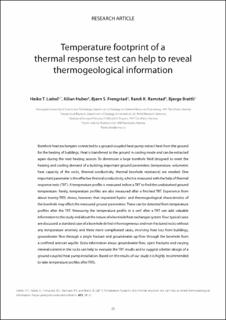| dc.description.abstract | Borehole heat exchangers connected to a ground-coupled heat pump extract heat from the ground for the heating of buildings. Heat is transferred to the ground in cooling mode and can be extracted again during the next heating season. To dimension a large borehole field designed to meet the heating and cooling demand of a building, important ground parameters (temperature, volumetric heat capacity of the rocks, thermal conductivity, thermal borehole resistance) are needed. One important parameter is the effective thermal conductivity, which is measured with the help of thermal response tests (TRT). A temperature profile is measured before a TRT to find the undisturbed ground temperature. Rarely, temperature profiles are also measured after a finished TRT. Experience from about twenty TRTs shows, however, that important hydro- and thermogeological characteristics of the borehole may affect the measured ground parameters. These can be detected from temperature profiles after the TRT. Measuring the temperature profile in a well after a TRT can add valuable information to the study and about the nature of a borehole heat exchanger system. Four typical cases are discussed: a standard case of a borehole drilled in homogeneous and non-fractured rocks without any temperature anomaly and three more complicated cases, involving heat loss from buildings, groundwater flow through a single fracture and groundwater up-flow through the borehole from a confined artesian aquifer. Extra information about groundwater flow, open fractures and varying mineral content in the rocks can help to evaluate the TRT results and to suggest a better design of a ground-coupled heat pump installation. Based on the results of our study it is highly recommended to take temperature profiles after TRTs. | |

